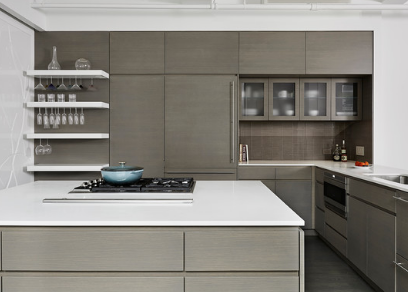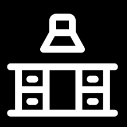Upper cabinets don’t have just one height or width, and they don’t have just one depth. Usually, the upper cabinet is much shallower than the lower cabinet, sometimes up to half deep. If you want to make the most of every inch of storage space in your kitchen, you’re missing out on some important space. That’s why you may want to consider an in-depth retrofit of your upper cabinets.

What Is Counter-Depth Upper Cabinet?
In a typical kitchen, we consider the upper and lower cabinets to be distinctly different, especially in terms of depth.
The lower cabinets along the wall are typically about 24 inches deep, with a 25-inch-deep counter at the top. The upper wall cabinet is shallow at 12 to 15 inches so as not to take up too much workspace. But for most cabinet collections, you can use an “anti-depth” or “full-depth” upper cabinet with the same depth as a typical lower cabinet.

In the same kitchen as in the previous photo, this angle shows that the espresso cabinets are all at the same depth.
Using a deep upper can have a variety of functions, the most basic being to provide more storage space.

Why Should You Use an Inverse Depth Upper?
In a compact kitchen, every inch of storage space helps, and counter-deep cabinetry gives you about 10 inches of storage space. This can go a long way.
In the examples so far, you can see that the short, deep upper is paired with a row of standard-depth uppers, which provides the best of both worlds. The deeper upper part is much higher than the countertop so it doesn’t obstruct the view when cooking, and the lower part of the standard depth can accommodate smaller items for quick access.

The reverse depth upper also makes sense in a kitchen with a spacious island as the main workspace. You can see in this kitchen that the back wall is mostly used as storage space, while there is only one minimal opening around the stove. The range hood and several upper cabinets are all of the same height and depth, giving this modern space a very clean and tidy appearance.

Another important use for deep upper cabinets is on the short walls of L-shaped or U-shaped kitchens. As you can see here, the deeper upper part above the counter leaves a perfect corner for storing small appliances or other countertop items, while the other sides are more practical counters for preparation and cooking.

Counter-Depth Upper Cabinet Style Creativity
While the spaces we’ve seen so far are all fairly modern, the idea can also work well in traditional or transitional spaces, like the one I designed for a client in Toronto in this example.
However, it’s important to consider that deeper upper cabinets will automatically appear a little “heavier” and will reduce the appearance of the space, so you’ll need to find some ways to lighten the overall look.

Using a lot of white always makes the kitchen feel more seamless and open, especially when it’s the finish of the cabinetry itself. In this example, the white upper cabinets and the white ceiling blend together, weakening the size of the cabinets and making the whole room appear bright and airy.

Going back to the traditional example, the cabinetry is rich in wood tones, but other finishes like counters and backsplashes incorporate a lot of white. The cabinets give a thick, mature feel, but there are still some visual breakthroughs to the overall space to keep it well balanced.

In this example, the darker upper cabinets match the white on the walls, so they almost look like they are part of the bulkhead above, while the other cabinets are all in a soft grey. The effect is subtle, but it looks almost as if the cabinets in the depths of the upper floor are non-existent, and all that comes into view is an elegant and airy kitchen.

Cabinet Under the Lamp
Bright under-cabinet lighting will make the open area above the counter feel bigger. They also create a focal point under the walls, so your eyes are drawn to the most open areas rather than bulky cabinets.

Glass Doors
All deep cabinets can be used to store functional items, and just a few short glass-door cabinets can give you a great place to store cups, bowls, and mugs, creating an attractive display case without much thought. The glass doors make the area feel less closed and provide interesting contrasts, again balancing the visual heaviness of the deeper upper.

Open Shelves
Like glass-door cabinets, floating shelves balance the weight of the upper deep cabinets with open storage. Upper cabinets are best for storing bulky items or items that you don’t touch often, so it makes sense to have some shelves underneath to store items you might want to grab quickly, such as salt and pepper or other cooking items or everyday essentials like glassware.
In this example, the shelves have a stainless steel finish, giving an extra hint of shimmering metal, a finish that may feel too much for some to use on the cabinet doors, but a small dose feels just right.

Two-Tone Cabinetry
Many of these examples use a two-tone cabinet look, which is also a fun way to add personality to a space. In general, it is safe to use the same finish for the darker upper and lower cabinet, and keep the contrasting material for the standard depth upper for an interesting but still logical and combined look.
However, if you have a larger kitchen, you can also try using a single material for the upper cabinets and pantry, and a second material for the rest of the “standard” cabinets. Note that in this kitchen, the material palette is mostly limited to a single wood tone and crisp white, so the look doesn’t become cluttered.

Again, in this example, the “featured” cabinetry in the middle complements the wood tones of the floor and island counter extensions, so the palette doesn’t become cloudy. You can see that the lower cabinets, the taller cabinets, and the deeper upper cabinets do not provide a natural breaking point for changing materials, so they look best to be seamless flat surfaces made of charcoal.

So, if you’re planning to renovate or build a new kitchen, ask your kitchen designer or cabinet maker what other creative combinations are available for your space before adopting a typical layout. You might be surprised at how many options exist.


